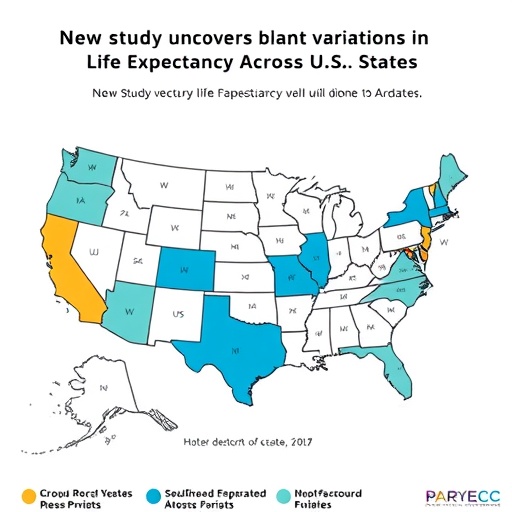A Century of Unequal Longevity: How Geography and Policy Sculpt Life Expectancy in the United States
In an extensive new investigation led by the Yale School of Public Health (YSPH), researchers have unveiled profound disparities in life expectancy trends throughout the United States over the last hundred years. This groundbreaking study reveals how the interplay between public health policies, social environments, and regional factors critically shapes the longevity of populations across states and the nation’s capital, Washington, D.C. By scrutinizing more than 179 million recorded deaths spanning from 1969 to 2020, investigators employed sophisticated cohort-based analyses, illuminating generational shifts in mortality that were previously obscured in traditional methods.
Unlike conventional mortality assessments that aggregate death rates by calendar year—thereby mixing generational experiences—the researchers utilized an age-period-cohort modeling approach. This method disentangles the influences of aging, historical context, and birth cohort, allowing for a more nuanced understanding of how early-life exposures and policies carve the trajectories of health and longevity. For example, factors such as access to clean water, vaccination programs, and the prevalence of tobacco use during formative years were all integrated into this model to assess their long-term effects on mortality risk.
The findings are striking: while states in the Northeast and West Coast, alongside the District of Columbia, achieved remarkable gains in life expectancy over the twentieth century, several Southern states remained largely stagnant. Specifically, females born in some parts of the South experienced life expectancy increases of less than three years between 1900 and 2000. In contrast, states like New York and California witnessed improvements exceeding two decades during the same interval. This stark contrast underscores the deep-seated systemic inequities entrenched in socioeconomic conditions and health infrastructure.
Washington, D.C., epitomizes the potential for transformation. Originally having the lowest life expectancy for the 1900 birth cohort, the district underwent rapid health improvements throughout the century. By 2000, females in the capital saw a 30-year increase in expected lifespan, while males experienced gains of 38 years, signaling successful public health interventions and socioeconomic development. This reversal illustrates how policy and environmental contexts can substantially alter demographic destiny across generations.
The persistent low gains in Southern states such as Mississippi, Alabama, and Kentucky raise concerns about the long-term consequences of entrenched disadvantages. These regions have historically grappled with limited health care access, entrenched poverty, and fewer robust public health initiatives. The study’s co-author Jamie Tam, an assistant professor of health policy and management at YSPH, connects these findings directly to socioeconomic status, noting the correlation between stagnant life expectancy and pervasive poverty. Without targeted interventions, these disparities are likely to endure or even exacerbate.
The research further delves into the dynamics of aging by examining mortality rate doubling times after age 35—a key indicator of healthy aging. States like New York and Florida demonstrated slower increases in mortality risk as individuals age, suggesting better health maintenance and risk factor mitigation. In contrast, states including Oklahoma and Iowa experienced sharper escalations, implying greater vulnerabilities in midlife health determinants. This metric offers additional insight into how environment and policy shape not only lifespan but also the quality of aging.
One of the clearest illustrations of policy impact comes from the divergent approaches to tobacco control between California and Kentucky. California’s early implementation of smoke-free workplace laws in 1995 fostered generational benefits by reducing exposure to harmful tobacco products, prompting cessation among working adults and establishing smoke-free norms for succeeding generations. Kentucky’s lack of comparable measures contributed to persistently high smoking rates and correlated mortality, placing it alongside other states with weaker tobacco regulations such as West Virginia, Oklahoma, Arkansas, Tennessee, Louisiana, Mississippi, and Alabama.
This tobacco-related disparity exemplifies how modifiable behaviors and policy decisions compound over time to influence mortality patterns. Changes in health behaviors, driven by legislation and public health campaigns, create ripple effects that enhance life expectancy not only immediately but across cohorts. The study’s design, emphasizing cohort analysis, is particularly adept at capturing these generational reverberations, which might be obscured in year-to-year mortality statistics.
Monumental socioeconomic factors also underscore these geographic divergences in longevity. Wealthier states with broader healthcare infrastructure, higher educational attainment, and stronger environmental protections tended to improve mortality metrics more rapidly. In contrast, states burdened by poverty and limited resources showed slower progress. The research advocates for an integrative approach to public health that recognizes these structural determinants as fundamental levers to reduce mortality inequalities.
The implications of this century-spanning investigation are urgent and policy-relevant. Without concerted efforts aimed at enhancing health care access, enforcing effective tobacco control, and mitigating environmental health risks, existing disparities will likely persist or even widen. The researchers call for a generational perspective in public health policymaking, one that appreciates how interventions today can substantively influence the health trajectories of future populations.
By illuminating the deep-rooted temporal and geographic dimensions of mortality disparities, the study challenges the long-standing notion that life expectancy is solely a matter of individual choices. Instead, it frames longevity as inextricably linked to the environments and policies shaping each generation’s lived experiences. As lead author Theodore R. Holford poignantly states, “Where you are born shouldn’t determine how long you live. But in America, it still does.” This realization underscores the essential need for equity-driven health policies capable of bridging these formidable gaps.
In concluding, the Yale team’s research not only provides a detailed historical landscape of life expectancy trends but also offers a clarion call for action. It emphasizes the importance of sustained public health investments and social reforms that address root causes across cohorts to ensure that the promise of longevity is accessible to all Americans, irrespective of geography. The study marks a pivotal advance in understanding how health inequities persist and evolve, carrying profound consequences for public health strategies in the years ahead.
—
Subject of Research: Life expectancy disparities and influencing factors across U.S. states and Washington, D.C., analyzed through cohort-based mortality modeling
Article Title: [Not specified in the original text]
News Publication Date: [Not specified; study published in JAMA Network Open]
Web References: [Not provided]
References: [Not provided; study appears in JAMA Network Open]
Image Credits: [Not provided]
Keywords: life expectancy, mortality disparities, public health policy, cohort analysis, tobacco control, socioeconomic factors, aging, U.S. states, health equity
Tags: access to healthcare and longevitycohort-based mortality analysisfactors affecting mortality riskgenerational shifts in life expectancygeographic influences on health outcomeshistorical context in life expectancyimpact of social environments on healthlife expectancy disparities in the United Statespublic health policies and longevityregional variations in health trendstobacco use and life expectancyvaccination programs and public health





